Mybatis learning record
SSM framework: of configuration file. The best way: look at the official website documents;
1. Introduction
1.1. What is Mybatis
- MyBatis is an excellent persistence layer framework
- It supports customized SQL, stored procedures, and advanced mapping.
- MyBatis avoids almost all JDBC code and manually setting parameters and getting result sets.
- MyBatis can use simple XML or annotations to configure and map native types, interfaces and Java POJO s (Plain Old Java Objects) as records in the database.
- MyBatis was apache An open source project iBatis In 2010, the project was migrated from apache software foundation to google code and renamed MyBatis.
- Moved to Github in November 2013.
How do I get Mybatis?
-
maven warehouse:
<!-- https://mvnrepository.com/artifact/org.mybatis/mybatis --> <dependency> <groupId>org.mybatis</groupId> <artifactId>mybatis</artifactId> <version>3.5.2</version> </dependency> -
Github : https://github.com/mybatis/mybatis-3/releases
-
Chinese documents: https://mybatis.org/mybatis-3/zh/index.html
1.2 persistence
Data persistence
- Persistence is the process of transforming program data in persistent state and transient state
- Memory: loss upon power failure
- Database (Jdbc), io file persistence.
- Life: refrigerate can.
Why persistence?
-
There are some objects that he can't lose.
-
Memory is too expensive
1.3. Durable layer
Dao layer, Service layer, Controller layer
- Code block that completes the persistence work
- The layer boundary is very obvious.
1.4 why do you need Mybatis?
- The helper program stores the data into the database.
- convenient
- Traditional JDBC code is too complex. simplify. Frame. Automation.
- You don't need Mybatis. Easier to use. There is no distinction between high and low technology
- advantage:
- Easy to learn
- flexible
- The separation of sql and code improves maintainability.
- Provide mapping labels to support the mapping between objects and orm fields in the database
- Provide object relationship mapping labels to support object relationship maintenance
- Provide xml tags to support writing dynamic sql.
The most important point: many people use it!
Spring SpringMVC SpringBoot
2. The first Mybatis program
Idea: build environment – > Import Mybatis – > write code – > test!
2.1. Construction environment
Build database
CREATE DATABASE `mybatis`; USE `mybatis`; CREATE TABLE `user`( `id` INT(20) NOT NULL PRIMARY KEY, `name` VARCHAR(30) DEFAULT NULL, `pwd` VARCHAR(30) DEFAULT NULL )ENGINE=INNODB DEFAULT CHARSET=utf8; INSERT INTO `user`(`id`,`name`,`pwd`) VALUES (1,'Mad God','123456'), (2,'Zhang San','123456'), (3,'Li Si','123890')
New project
-
Create a normal maven project
-
Delete src directory
-
Import maven dependencies
<!--Import dependency--> <dependencies> <!--mysql drive--> <dependency> <groupId>mysql</groupId> <artifactId>mysql-connector-java</artifactId> <version>5.1.47</version> </dependency> <!--mybatis--> <!-- https://mvnrepository.com/artifact/org.mybatis/mybatis --> <dependency> <groupId>org.mybatis</groupId> <artifactId>mybatis</artifactId> <version>3.5.2</version> </dependency> <!--junit--> <dependency> <groupId>junit</groupId> <artifactId>junit</artifactId> <version>4.12</version> </dependency> </dependencies>
2.2. Create a module
-
Write the core configuration file of mybatis
<?xml version="1.0" encoding="UTF-8" ?> <!DOCTYPE configuration PUBLIC "-//mybatis.org//DTD Config 3.0//EN" "http://mybatis.org/dtd/mybatis-3-config.dtd"> <!--configuration Core profile--> <configuration> <environments default="development"> <environment id="development"> <transactionManager type="JDBC"/> <dataSource type="POOLED"> <property name="driver" value="com.mysql.jdbc.Driver"/> <property name="url" value="jdbc:mysql://localhost:3306/mybatis?useSSL=true&useUnicode=true&characterEncoding=UTF-8"/> <property name="username" value="root"/> <property name="password" value="123456"/> </dataSource> </environment> </environments> </configuration> -
Write mybatis tool class
//sqlSessionFactory --> sqlSession public class MybatisUtils { private static SqlSessionFactory sqlSessionFactory; static{ try { //Step 1 of using Mybatis: get sqlSessionFactory object String resource = "mybatis-config.xml"; InputStream inputStream = Resources.getResourceAsStream(resource); sqlSessionFactory = new SqlSessionFactoryBuilder().build(inputStream); } catch (IOException e) { e.printStackTrace(); } } //Now that we have SqlSessionFactory, as the name suggests, we can get an instance of SqlSession from it. // SqlSession completely contains all the methods required to execute SQL commands facing the database. public static SqlSession getSqlSession(){ return sqlSessionFactory.openSession(); } }
2.3. Code writing
-
Entity class
package com.kuang.pojo; //Entity class public class User { private int id; private String name; private String pwd; public User() { } public User(int id, String name, String pwd) { this.id = id; this.name = name; this.pwd = pwd; } public int getId() { return id; } public void setId(int id) { this.id = id; } public String getName() { return name; } public void setName(String name) { this.name = name; } public String getPwd() { return pwd; } public void setPwd(String pwd) { this.pwd = pwd; } @Override public String toString() { return "User{" + "id=" + id + ", name='" + name + '\'' + ", pwd='" + pwd + '\'' + '}'; } } -
Dao interface
public interface UserDao { List<User> getUserList(); } -
The interface implementation class is transformed from the original UserDaoImpl into a Mapper configuration file
<?xml version="1.0" encoding="UTF-8" ?> <!DOCTYPE mapper PUBLIC "-//mybatis.org//DTD Mapper 3.0//EN" "http://mybatis.org/dtd/mybatis-3-mapper.dtd"> <!--namespace=Bind a corresponding Dao/Mapper Interface--> <mapper namespace="com.kuang.dao.UserDao"> <!--select Query statement--> <select id="getUserList" resultType="com.kuang.pojo.User"> select * from mybatis.user </select> </mapper>
2.4 test
Note:
org.apache.ibatis.binding.BindingException: Type interface com.kuang.dao.UserDao is not known to the MapperRegistry.
What is MapperRegistry?
Register mappers in the core configuration file
-
junit test
@Test public void test(){ //Step 1: get SqlSession object SqlSession sqlSession = MybatisUtils.getSqlSession(); //Method 1: getMapper UserDao userDao = sqlSession.getMapper(UserDao.class); List<User> userList = userDao.getUserList(); for (User user : userList) { System.out.println(user); } //Close SqlSession sqlSession.close(); }
You can the problems you will encounter:
- The profile is not registered
- Binding interface error.
- Wrong method name
- Wrong return type
- Maven export resource problem
3,CRUD
1,namespace
The package name in namespace should be consistent with the package name of Dao/mapper interface!
2,select
Select, query statement;
- id: is the method name in the corresponding namespace;
- resultType: return value of Sql statement execution!
- Parameter type: parameterType!
-
Write interface
//Query user by ID User getUserById(int id);
-
Write the sql statement in the corresponding mapper
<select id="getUserById" parameterType="int" resultType="com.kuang.pojo.User"> select * from mybatis.user where id = #{id} </select> -
test
@Test public void getUserById() { SqlSession sqlSession = MybatisUtils.getSqlSession(); UserMapper mapper = sqlSession.getMapper(UserMapper.class); User user = mapper.getUserById(1); System.out.println(user); sqlSession.close(); }
3,Insert
<!--The properties in the object can be taken out directly-->
<insert id="addUser" parameterType="com.kuang.pojo.User">
insert into mybatis.user (id, name, pwd) values (#{id},#{name},#{pwd});
</insert>
4,update
<update id="updateUser" parameterType="com.kuang.pojo.User">
update mybatis.user set name=#{name},pwd=#{pwd} where id = #{id} ;
</update>
5,Delete
<delete id="deleteUser" parameterType="int">
delete from mybatis.user where id = #{id};
</delete>
Note:
- Add, delete and modify transactions that need to be submitted!
6. Analysis error
- Don't match the labels wrong
- resource binding mapper requires a path!
- The program configuration file must comply with the specification!
- NullPointerException, not registered to resource!
- There is a problem of Chinese garbled code in the output xml file!
- maven resources have no export problem!
7. Universal Map
Assuming that there are too many entity classes or tables, fields or parameters in the database, we should consider using Map!
//Universal Map
int addUser2(Map<String,Object> map);
<!--The properties in the object can be taken out directly transmit map of key-->
<insert id="addUser" parameterType="map">
insert into mybatis.user (id, pwd) values (#{userid},#{passWord});
</insert>
@Test
public void addUser2(){
SqlSession sqlSession = MybatisUtils.getSqlSession();
UserMapper mapper = sqlSession.getMapper(UserMapper.class);
Map<String, Object> map = new HashMap<String, Object>();
map.put("userid",5);
map.put("passWord","2222333");
mapper.addUser2(map);
sqlSession.close();
}
Transfer parameters from map and directly take out the key from sql! [parameterType=“map”]
Pass parameters to the object and directly get the attribute of the object in sql! [parameterType=“Object”]
If there is only one basic type parameter, you can get it directly in sql!
Use Map or annotation for multiple parameters!
8. Thinking questions
How to write fuzzy query?
-
When executing Java code, pass wildcard%%
List<User> userList = mapper.getUserLike("%Lee%"); -
Use wildcards in sql splicing!
select * from mybatis.user where name like "%"#{value}"%"
4. Configuration resolution
1. Core profile
-
mybatis-config.xml
-
The MyBatis configuration file contains settings and attribute information that will deeply affect MyBatis behavior.
configuration(Configuration) properties(Properties) settings(Settings) typeAliases(Type alias) typeHandlers(Type (processor) objectFactory(Object factory) plugins(Plug in) environments(Environment configuration) environment(Environment variables) transactionManager(Transaction manager) dataSource((data source) databaseIdProvider(Database (manufacturer identification) mappers(Mapper)
2. Environment configurations
MyBatis can be configured to adapt to a variety of environments
However, remember that although multiple environments can be configured, only one environment can be selected for each SqlSessionFactory instance.
Learn to use and configure multiple operating environments!
The default transaction manager of Mybatis is JDBC, and the connection pool is POOLED
3. properties
We can reference the configuration file through the properties attribute
These properties are externally configurable and dynamically replaceable. They can be configured in a typical Java property file or passed through the child elements of the properties element. [db.properties]
Write a configuration file
db.properties
driver=com.mysql.jdbc.Driver url=jdbc:mysql://localhost:3306/mybatis?useSSL=true&useUnicode=true&characterEncoding=UTF-8 username=root password=123456
Mapping in core configuration file
<!--Import external profile-->
<properties resource="db.properties">
<property name="username" value="root"/>
<property name="pwd" value="11111"/>
</properties>
- You can import external files directly
- You can add some attribute configurations
- If there are two fields in the external configuration file, it takes precedence!
4. Type aliases
- A type alias is a short name for a Java type‘
- The meaning of existence is only to reduce the redundancy of class fully qualified names.
<!--You can alias an entity class-->
<typeAliases>
<typeAlias type="com.kuang.pojo.User" alias="User"/>
</typeAliases>
You can also specify a package name. MyBatis will search for the required Java beans under the package name, such as:
Scan the package of the entity class, and its default alias is the class name of this class, with the first letter in lowercase!
<!--You can alias an entity class-->
<typeAliases>
<package name="com.kuang.pojo"/>
</typeAliases>
The first method is used when there are few entity classes.
If there are many entity classes, the second one is recommended.
The first can be a DIY alias, and the second can't. If you have to change it, you need to add annotations on the entity
@Alias("user")
public class User {}
5. Set
These are extremely important tuning settings in MyBatis, which will change the runtime behavior of MyBatis.


6. Other configurations
- typeHandlers
- objectFactory (object factory)
- plugins plug-in
- mybatis-generator-core
- mybatis-plus
- General mapper
7. mappers
MapperRegistry: register and bind our Mapper file;
Method 1: [recommended]
<!--every last Mapper.XML All need to be in Mybatis Register in the core configuration file!-->
<mappers>
<mapper resource="com/kuang/dao/UserMapper.xml"/>
</mappers>
Method 2: register with class file binding
<!--every last Mapper.XML All need to be in Mybatis Register in the core configuration file!-->
<mappers>
<mapper class="com.kuang.dao.UserMapper"/>
</mappers>
Note:
- Interface and its Mapper configuration file must have the same name!
- The interface and its Mapper configuration file must be in the same package!
Method 3: use scanning package for injection binding
<!--every last Mapper.XML All need to be in Mybatis Register in the core configuration file!-->
<mappers>
<package name="com.kuang.dao"/>
</mappers>
Note:
- Interface and its Mapper configuration file must have the same name!
- The interface and its Mapper configuration file must be in the same package!
8. Lifecycle and scope
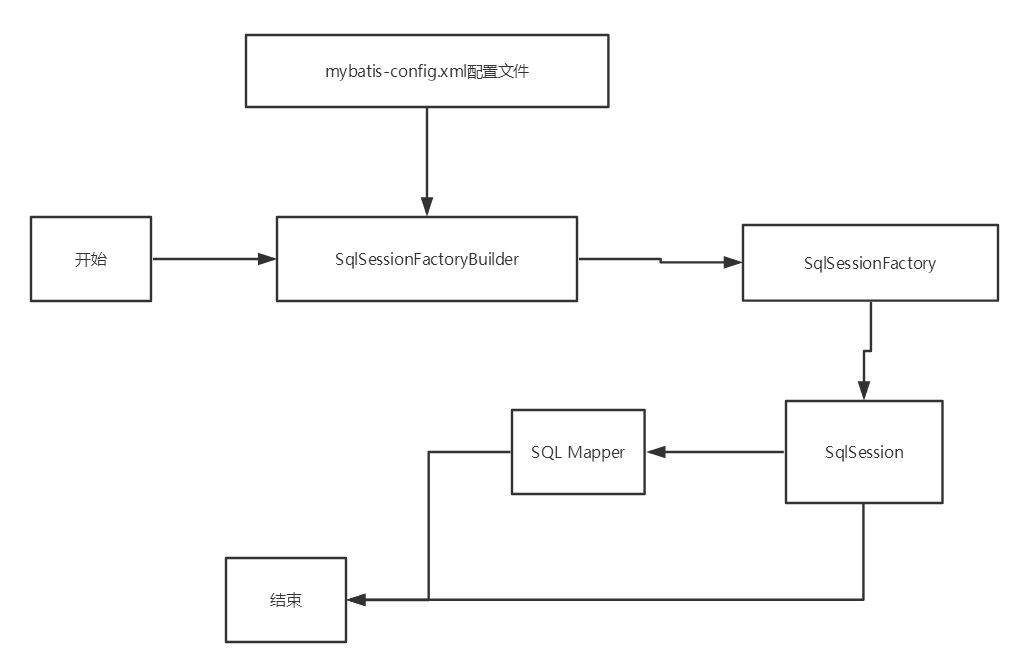
Life cycle, and scope, are crucial because incorrect use can lead to very serious concurrency problems.
SqlSessionFactoryBuilder:
- Once SqlSessionFactory is created, it is no longer needed
- local variable
SqlSessionFactory:
- To put it bluntly, it can be imagined as: database connection pool
- Once SqlSessionFactory is created, it should always exist during the operation of the application. There is no reason to discard it or recreate another instance.
- Therefore, the best scope of SqlSessionFactory is the application scope.
- The simplest is to use singleton mode or static singleton mode.
SqlSession
- A request to connect to the connection pool!
- The instance of SqlSession is not thread safe, so it cannot be shared, so its best scope is the request or method scope.
- You need to close it immediately after using it up, otherwise the resources will be occupied!
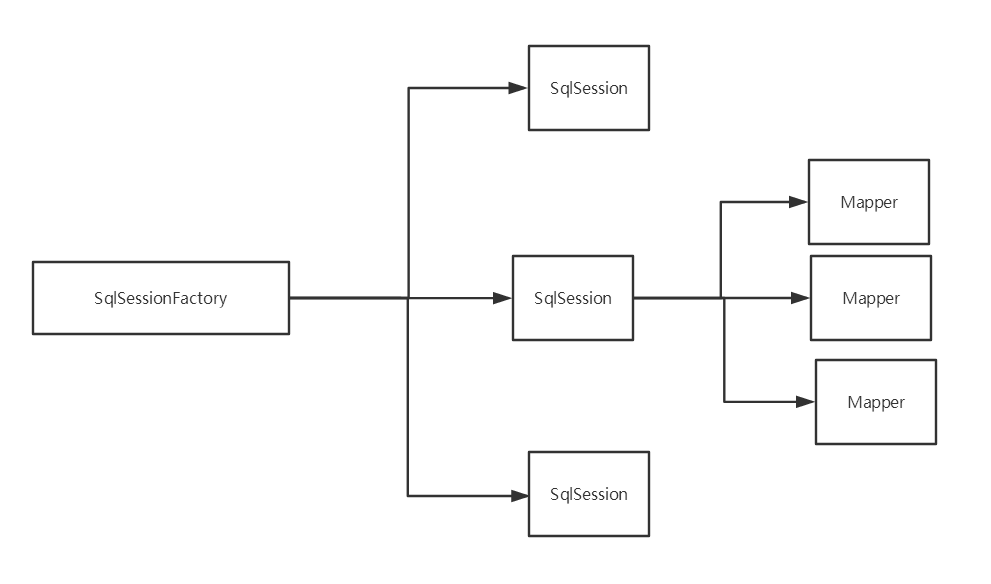
Each Mapper in this represents a specific business!
5. Solve the problem of inconsistency between attribute name and field name
1. Question
Fields in the database
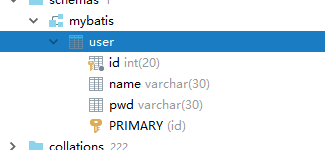
Create a new project and test the inconsistency of entity class fields before copying
public class User {
private int id;
private String name;
private String password;
}
There is a problem with the test

// select * from mybatis.user where id = #{id}
//Type processor
// select id,name,pwd from mybatis.user where id = #{id}
resolvent:
-
Alias
<select id="getUserById" resultType="com.kuang.pojo.User"> select id,name,pwd as password from mybatis.user where id = #{id} </select>
2,resultMap
Result set mapping
id name pwd id name password
<!--Result set mapping-->
<resultMap id="UserMap" type="User">
<!--column Fields in the database, property Properties in entity classes-->
<result column="id" property="id"/>
<result column="name" property="name"/>
<result column="pwd" property="password"/>
</resultMap>
<select id="getUserById" resultMap="UserMap">
select * from mybatis.user where id = #{id}
</select>
- The resultMap element is the most important and powerful element in MyBatis
- The design idea of ResultMap is that there is no need to configure explicit result mapping for simple statements, but only need to describe their relationship for more complex statements.
- The best thing about ResultMap is that although you already know it well, you don't need to explicitly use them at all.
6. Log
6.1 log factory
If an exception occurs in a database operation, we need to troubleshoot it. Log is the best assistant!
Once: South, debug
Now: log factory!

-
SLF4J
-
LOG4J [Master]
-
LOG4J2
-
JDK_LOGGING
-
COMMONS_LOGGING
-
STDOUT_LOGGING [mastering]
-
NO_LOGGING
Which log implementation is used in Mybatis? Set it in settings!
STDOUT_LOGGING standard log output
In the mybatis core configuration file, configure our logs!
<settings>
<setting name="logImpl" value="STDOUT_LOGGING"/>
</settings>

6.2,Log4j
What is Log4j?
- Log4j yes Apache By using Log4j, we can control the destination of log information transmission Console , documents GUI assembly
- We can also control the output format of each log;
- By defining the level of each log information, we can control the log generation process in more detail.
- Through a configuration file To flexibly configure without modifying the application code.
-
Import the package of log4j first
<!-- https://mvnrepository.com/artifact/log4j/log4j --> <dependency> <groupId>log4j</groupId> <artifactId>log4j</artifactId> <version>1.2.17</version> </dependency> -
log4j.properties
#Output the log information with the level of DEBUG to the two destinations of console and file. The definitions of console and file are in the following code log4j.rootLogger=DEBUG,console,file #Relevant settings of console output log4j.appender.console = org.apache.log4j.ConsoleAppender log4j.appender.console.Target = System.out log4j.appender.console.Threshold=DEBUG log4j.appender.console.layout = org.apache.log4j.PatternLayout log4j.appender.console.layout.ConversionPattern=[%c]-%m%n #Relevant settings for file output log4j.appender.file = org.apache.log4j.RollingFileAppender log4j.appender.file.File=./log/kuang.log log4j.appender.file.MaxFileSize=10mb log4j.appender.file.Threshold=DEBUG log4j.appender.file.layout=org.apache.log4j.PatternLayout log4j.appender.file.layout.ConversionPattern=[%p][%d{yy-MM-dd}][%c]%m%n #Log output level log4j.logger.org.mybatis=DEBUG log4j.logger.java.sql=DEBUG log4j.logger.java.sql.Statement=DEBUG log4j.logger.java.sql.ResultSet=DEBUG log4j.logger.java.sql.PreparedStatement=DEBUG -
Configure log4j as the implementation of log
<settings> <setting name="logImpl" value="Log4j"/> </settings> -
Use of Log4j!, Run the query directly
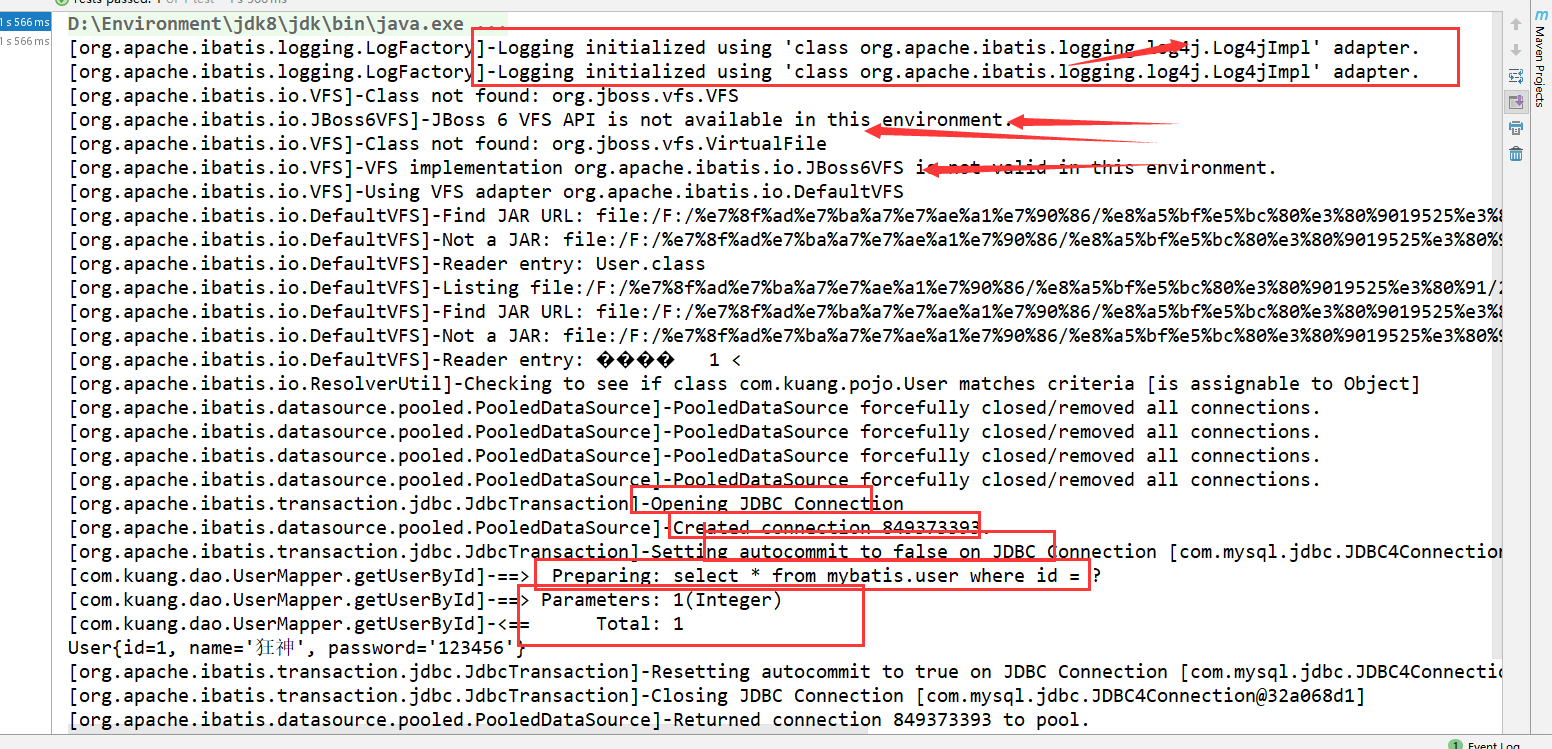
Simple use
-
In the class to use Log4j, import the package import org apache. Log4j. Logger;
-
Log object. The parameter is the class of the current class
static Logger logger = Logger.getLogger(UserDaoTest.class);
-
log level
logger.info("info:Entered testLog4j"); logger.debug("debug:Entered testLog4j"); logger.error("error:Entered testLog4j");
7. Pagination
Think: why pagination?
- Reduce data processing
7.1. Use Limit paging
Syntax: SELECT * from user limit startIndex,pageSize; SELECT * from user limit 3; #[0,n]
Use Mybatis to realize paging and core SQL
-
Interface
//paging List<User> getUserByLimit(Map<String,Integer> map);
-
Mapper.xml
<!--//Paging -- > <select id="getUserByLimit" parameterType="map" resultMap="UserMap"> select * from mybatis.user limit #{startIndex},#{pageSize} </select> -
test
@Test public void getUserByLimit(){ SqlSession sqlSession = MybatisUtils.getSqlSession(); UserMapper mapper = sqlSession.getMapper(UserMapper.class); HashMap<String, Integer> map = new HashMap<String, Integer>(); map.put("startIndex",1); map.put("pageSize",2); List<User> userList = mapper.getUserByLimit(map); for (User user : userList) { System.out.println(user); } sqlSession.close(); }
7.2 rowboundaries paging
No longer use SQL for paging
-
Interface
//Pagination 2 List<User> getUserByRowBounds();
-
mapper.xml
<!--Pagination 2--> <select id="getUserByRowBounds" resultMap="UserMap"> select * from mybatis.user </select> -
test
@Test public void getUserByRowBounds(){ SqlSession sqlSession = MybatisUtils.getSqlSession(); //RowBounds implementation RowBounds rowBounds = new RowBounds(1, 2); //Paging through Java code level List<User> userList = sqlSession.selectList("com.kuang.dao.UserMapper.getUserByRowBounds",null,rowBounds); for (User user : userList) { System.out.println(user); } sqlSession.close(); }
7.3 paging plug-in
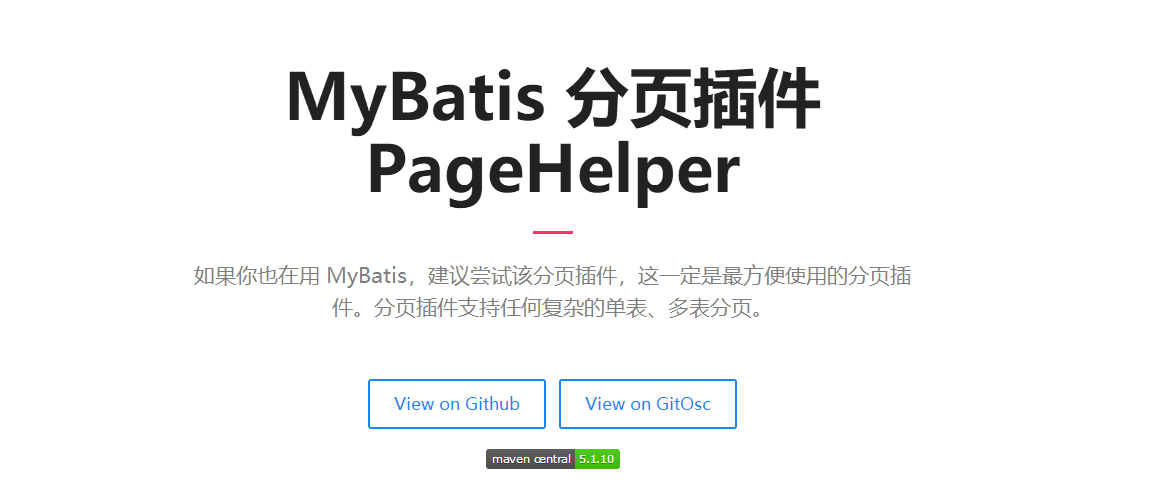
Just understand. If the company's architect says to use it in the future, you need to know what it is!
8. Using annotation development
8.1 interface oriented programming
-Everyone has studied object-oriented programming and interface before, but in real development, we often choose interface oriented programming
-Root cause: decoupling, expandable, improved reuse. In layered development, the upper layer doesn't care about the specific implementation. Everyone abides by common standards, making the development easier and more standardized
-In an object-oriented system, various functions of the system are completed by many different objects. In this case, how each object implements itself is not so important for system designers;
-The collaborative relationship between various objects has become the key of system design. From the communication between different classes to the interaction between modules, we should focus on it at the beginning of system design, which is also the main work of system design. Interface oriented programming refers to programming according to this idea.
Understanding of interface
-From a deeper understanding, the interface should be the separation of definition (specification, constraint) and Implementation (the principle of separation of name and reality).
-The interface itself reflects the system designer's abstract understanding of the system.
-There shall be two types of interfaces:
-The first type is the abstraction of an individual, which can correspond to an abstract class;
-The second is the abstraction of an aspect of an individual, that is, the formation of an abstract interface;
-An individual may have multiple Abstract faces. Abstract body and abstract surface are different.
Three oriented differences
-Object oriented means that when we consider a problem, we take the object as the unit and consider its attributes and methods
-Process oriented means that when we consider a problem, we consider its implementation in a specific process (transaction process)
-Interface design and non - interface design is not a problem It is more reflected in the overall architecture of the system
8.2 development using annotations
-
Annotation is implemented on the interface
@Select("select * from user") List<User> getUsers(); -
You need to bind the interface in the core configuration file!
<!--Binding interface--> <mappers> <mapper class="com.kuang.dao.UserMapper"/> </mappers> -
test
Essence: reflection mechanism implementation
Bottom layer: dynamic agent!
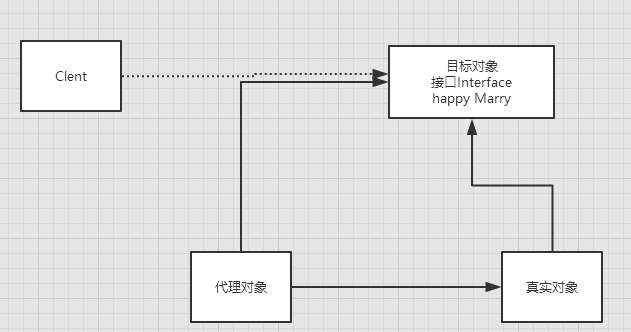
Mybatis detailed execution process!
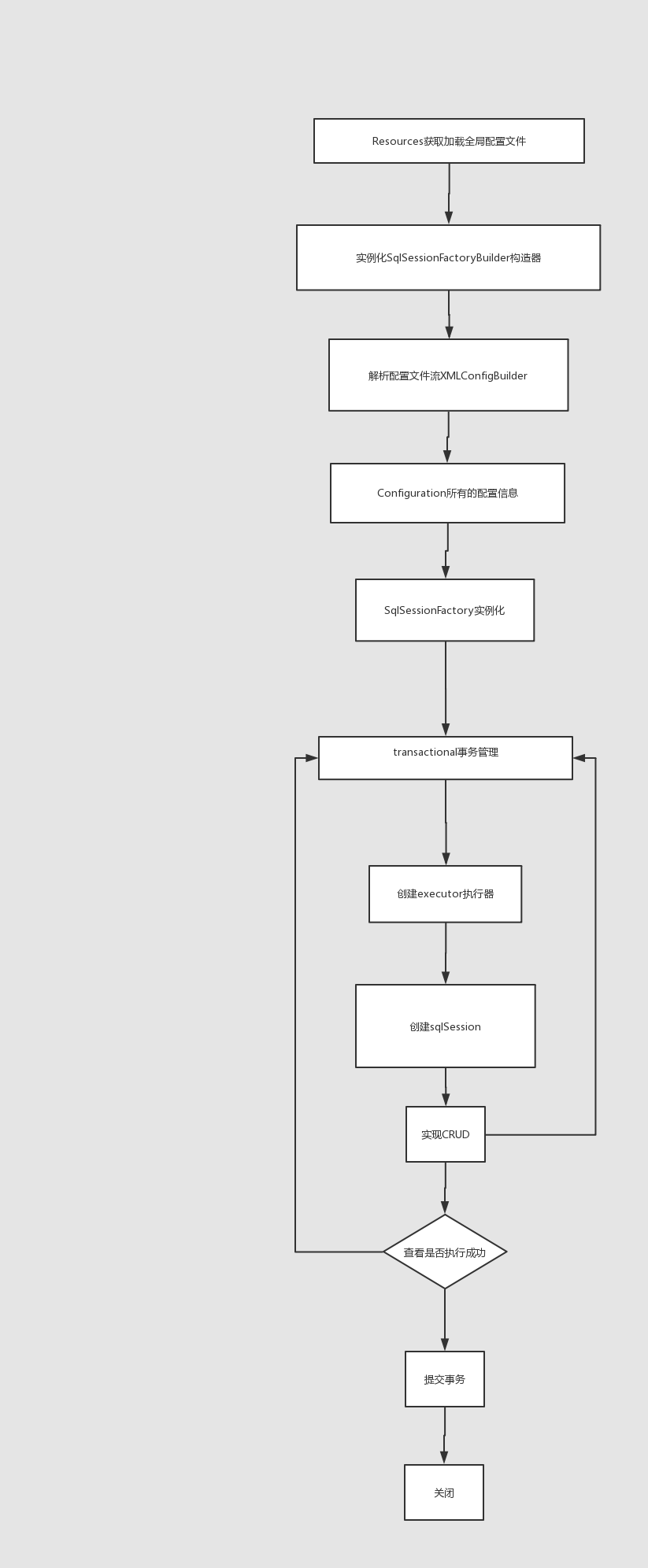
8.3,CRUD
We can automatically commit transactions when the tool class is created!
public static SqlSession getSqlSession(){
return sqlSessionFactory.openSession(true);
}
Write the interface and add comments
public interface UserMapper {
@Select("select * from user")
List<User> getUsers();
// Method has multiple parameters. All parameters must be preceded by @ Param("id") annotation
@Select("select * from user where id = #{id}")
User getUserByID(@Param("id") int id);
@Insert("insert into user(id,name,pwd) values (#{id},#{name},#{password})")
int addUser(User user);
@Update("update user set name=#{name},pwd=#{password} where id = #{id}")
int updateUser(User user);
@Delete("delete from user where id = #{uid}")
int deleteUser(@Param("uid") int id);
}
Test class
[Note: we must bind the interface registration to our core configuration file!]
About @ Param() annotation
- Parameters of basic type or String type need to be added
- The reference type does not need to be added
- If there is only one basic type, it can be ignored, but it is recommended that everyone add it!
- What we refer to in SQL is the attribute name set in @ Param()!
#{} ${} difference
9,Lombok
Project Lombok is a java library that automatically plugs into your editor and build tools, spicing up your java. Never write another getter or equals method again, with one annotation your class has a fully featured builder, Automate your logging variables, and much more.
- java library
- plugs
- build tools
- with one annotation your class
Use steps:
-
Install Lombok plug-in in IDEA!
-
Import the jar package of lombok in the project
<dependency> <groupId>org.projectlombok</groupId> <artifactId>lombok</artifactId> <version>1.18.10</version> </dependency> -
Just annotate the entity class!
@Data @AllArgsConstructor @NoArgsConstructor
@Getter and @Setter @FieldNameConstants @ToString @EqualsAndHashCode @AllArgsConstructor, @RequiredArgsConstructor and @NoArgsConstructor @Log, @Log4j, @Log4j2, @Slf4j, @XSlf4j, @CommonsLog, @JBossLog, @Flogger @Data @Builder @Singular @Delegate @Value @Accessors @Wither @SneakyThrows
explain:
@Data: Nonparametric structure, get,set,tostring,hashcode,equals @AllArgsConstructor @NoArgsConstructor @EqualsAndHashCode @ToString @Getter
10. Many to one processing
Many to one:
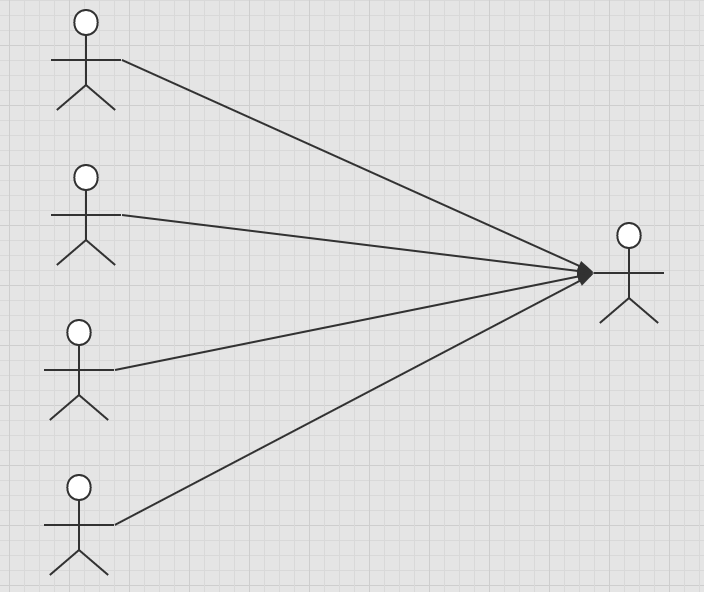
- Multiple students correspond to one teacher
- For students, it is related to... Multiple students and one teacher [many to one]
- For teachers, a collection, a teacher, has many students [one to many]
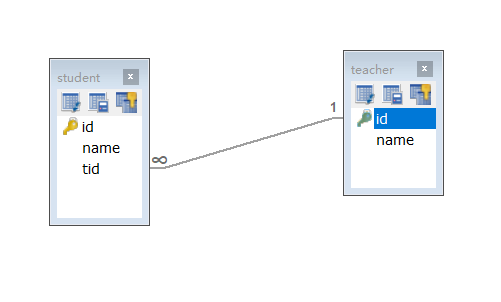
SQL:
CREATE TABLE `teacher` (
`id` INT(10) NOT NULL,
`name` VARCHAR(30) DEFAULT NULL,
PRIMARY KEY (`id`)
) ENGINE=INNODB DEFAULT CHARSET=utf8
INSERT INTO teacher(`id`, `name`) VALUES (1, 'Miss Qin');
CREATE TABLE `student` (
`id` INT(10) NOT NULL,
`name` VARCHAR(30) DEFAULT NULL,
`tid` INT(10) DEFAULT NULL,
PRIMARY KEY (`id`),
KEY `fktid` (`tid`),
CONSTRAINT `fktid` FOREIGN KEY (`tid`) REFERENCES `teacher` (`id`)
) ENGINE=INNODB DEFAULT CHARSET=utf8
INSERT INTO `student` (`id`, `name`, `tid`) VALUES ('1', 'Xiao Ming', '1');
INSERT INTO `student` (`id`, `name`, `tid`) VALUES ('2', 'Xiao Hong', '1');
INSERT INTO `student` (`id`, `name`, `tid`) VALUES ('3', 'Xiao Zhang', '1');
INSERT INTO `student` (`id`, `name`, `tid`) VALUES ('4', 'petty thief', '1');
INSERT INTO `student` (`id`, `name`, `tid`) VALUES ('5', 'Xiao Wang', '1');
Test environment construction
- Import lombok
- New entity class Teacher, Student
- Establish Mapper interface
- Create mapper XML file
- Bind and register our Mapper interface or file in the core configuration file! [there are many ways to choose]
- Test whether the query is successful!
Nested processing by query
<!--
thinking:
1. Query all student information
2. According to the student's tid,Find the corresponding teacher! Subquery
-->
<select id="getStudent" resultMap="StudentTeacher">
select * from student
</select>
<resultMap id="StudentTeacher" type="Student">
<result property="id" column="id"/>
<result property="name" column="name"/>
<!--For complex attributes, we need to deal with objects separately: association Set: collection -->
<association property="teacher" column="tid" javaType="Teacher" select="getTeacher"/>
</resultMap>
<select id="getTeacher" resultType="Teacher">
select * from teacher where id = #{id}
</select>
Nested processing according to results
<!--Nested processing according to results-->
<select id="getStudent2" resultMap="StudentTeacher2">
select s.id sid,s.name sname,t.name tname
from student s,teacher t
where s.tid = t.id;
</select>
<resultMap id="StudentTeacher2" type="Student">
<result property="id" column="sid"/>
<result property="name" column="sname"/>
<association property="teacher" javaType="Teacher">
<result property="name" column="tname"/>
</association>
</resultMap>
Review the Mysql many to one query method:
- Subquery
- Join table query
11. One to many processing
For example: a teacher has multiple students!
For teachers, it is a one to many relationship!
Environment construction
- The environment is the same as just now
Entity class
@Data
public class Student {
private int id;
private String name;
private int tid;
}
@Data
public class Teacher {
private int id;
private String name;
//A teacher has more than one student
private List<Student> students;
}
Nested processing according to results
<!--Nested query by result-->
<select id="getTeacher" resultMap="TeacherStudent">
select s.id sid, s.name sname, t.name tname,t.id tid
from student s,teacher t
where s.tid = t.id and t.id = #{tid}
</select>
<resultMap id="TeacherStudent" type="Teacher">
<result property="id" column="tid"/>
<result property="name" column="tname"/>
<!--For complex attributes, we need to deal with objects separately: association Set: collection
javaType="" Specify the type of attribute!
We use the generic information in the collection ofType obtain
-->
<collection property="students" ofType="Student">
<result property="id" column="sid"/>
<result property="name" column="sname"/>
<result property="tid" column="tid"/>
</collection>
</resultMap>
Nested processing by query
<select id="getTeacher2" resultMap="TeacherStudent2">
select * from mybatis.teacher where id = #{tid}
</select>
<resultMap id="TeacherStudent2" type="Teacher">
<collection property="students" javaType="ArrayList" ofType="Student" select="getStudentByTeacherId" column="id"/>
</resultMap>
<select id="getStudentByTeacherId" resultType="Student">
select * from mybatis.student where tid = #{tid}
</select>
Summary
- association - association [many to one]
- Set - collection [one to many]
- javaType & ofType
- JavaType is used to specify the type of attribute in the entity class
- ofType is used to specify the pojo type mapped to List or collection, and the constraint type in generic type!
Note:
- Ensure the readability of SQL and make it easy to understand as much as possible
- Pay attention to the problem of attribute names and fields in one to many and many to one!
- If the problem is difficult to troubleshoot, log can be used. Log4j is recommended
Slow SQL 1s 1000s
Interview frequency
- Mysql engine
- InnoDB underlying principle
- Indexes
- Index optimization!
12. Dynamic SQL
What is dynamic SQL: dynamic SQL refers to generating different SQL statements according to different conditions
Using the feature of dynamic SQL can completely get rid of this pain.
dynamic SQL Element and JSTL Or based on similar XML Similar to our text processor. stay MyBatis In previous versions, there were many elements that took time to understand. MyBatis 3 The element types have been greatly simplified. Now you only need to learn half of the original elements. MyBatis Adopt powerful based OGNL To eliminate most of the other elements. if choose (when, otherwise) trim (where, set) foreach
Build environment
CREATE TABLE `blog` ( `id` varchar(50) NOT NULL COMMENT 'Blog id', `title` varchar(100) NOT NULL COMMENT 'Blog title', `author` varchar(30) NOT NULL COMMENT 'Blogger', `create_time` datetime NOT NULL COMMENT 'Creation time', `views` int(30) NOT NULL COMMENT 'Views' ) ENGINE=InnoDB DEFAULT CHARSET=utf8
Create a basic project
-
Guide Package
-
Write configuration file
-
Writing entity classes
@Data public class Blog { private int id; private String title; private String author; private Date createTime; private int views; } -
Write entity classes corresponding to Mapper interface and Mapper XML file
IF
<select id="queryBlogIF" parameterType="map" resultType="blog">
select * from mybatis.blog where 1=1
<if test="title != null">
and title = #{title}
</if>
<if test="author != null">
and author = #{author}
</if>
</select>
choose (when, otherwise)
<select id="queryBlogChoose" parameterType="map" resultType="blog">
select * from mybatis.blog
<where>
<choose>
<when test="title != null">
title = #{title}
</when>
<when test="author != null">
and author = #{author}
</when>
<otherwise>
and views = #{views}
</otherwise>
</choose>
</where>
</select>
trim (where,set)
select * from mybatis.blog
<where>
<if test="title != null">
title = #{title}
</if>
<if test="author != null">
and author = #{author}
</if>
</where>
<update id="updateBlog" parameterType="map">
update mybatis.blog
<set>
<if test="title != null">
title = #{title},
</if>
<if test="author != null">
author = #{author}
</if>
</set>
where id = #{id}
</update>
The so-called dynamic SQL is still an SQL statement in essence, but we can execute a logical code at the SQL level
if
where , set , choose ,when
SQL fragment
Sometimes, we may extract some functions for reuse!
-
Extract common parts using SQL Tags
<sql id="if-title-author"> <if test="title != null"> title = #{title} </if> <if test="author != null"> and author = #{author} </if> </sql> -
Use the Include tag reference where necessary
<select id="queryBlogIF" parameterType="map" resultType="blog"> select * from mybatis.blog <where> <include refid="if-title-author"></include> </where> </select>
matters needing attention:
- It is best to define SQL fragments based on a single table!
- Do not have a where tag
Foreach
select * from user where 1=1 and
<foreach item="id" collection="ids"
open="(" separator="or" close=")">
#{id}
</foreach>
(id=1 or id=2 or id=3)
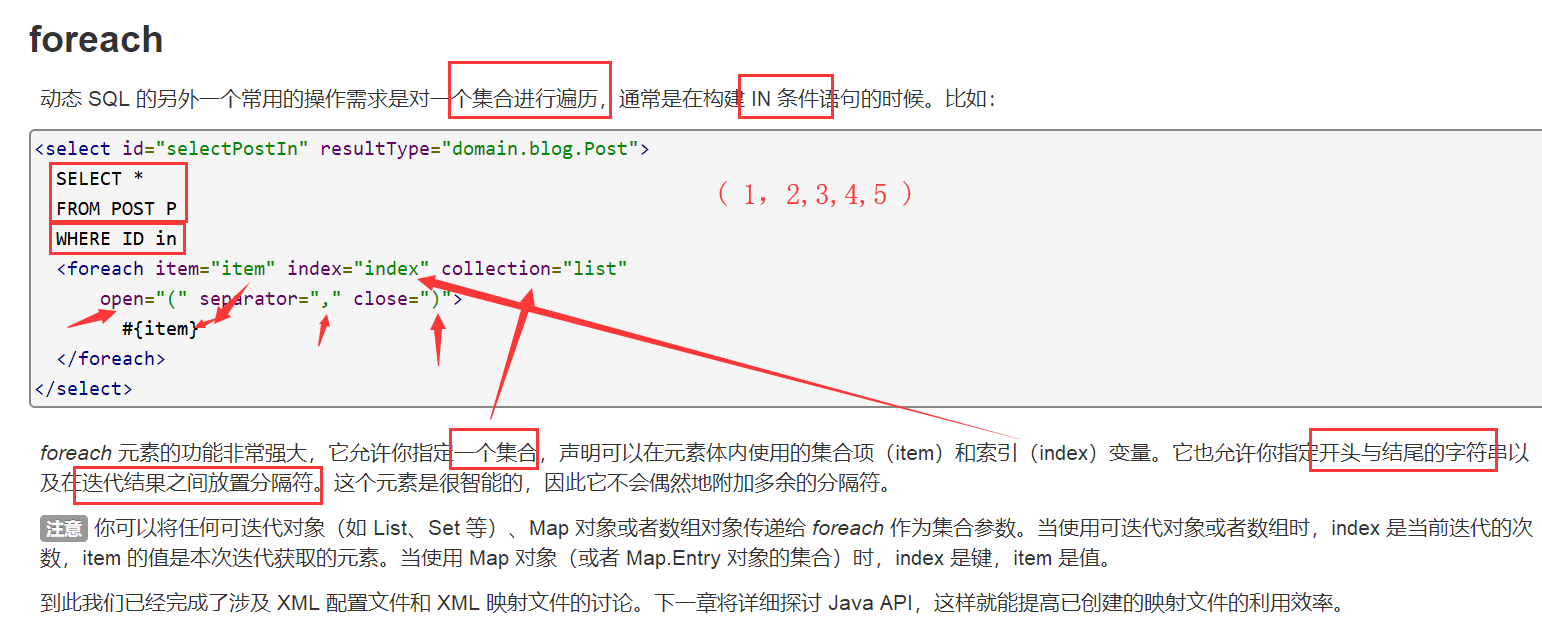

<!--
select * from mybatis.blog where 1=1 and (id=1 or id = 2 or id=3)
We are now passing on a universal message map , this map There can be a collection in!
-->
<select id="queryBlogForeach" parameterType="map" resultType="blog">
select * from mybatis.blog
<where>
<foreach collection="ids" item="id" open="and (" close=")" separator="or">
id = #{id}
</foreach>
</where>
</select>
Dynamic SQL is splicing SQL statements. We just need to ensure the correctness of SQL and arrange and combine them according to the format of SQL
Recommendations:
- First write a complete SQL in Mysql, and then modify it accordingly to become our dynamic SQL, which can be used for general purpose!
13. Cache (understand)
13.1 introduction
Query: connect to the database and consume resources! The result of a query will be temporarily stored in a place that can be directly accessed!--> Memory: caching When we query the same data again, we directly use the cache instead of the database
-
What is Cache?
- There is temporary data in memory.
- Put the data frequently queried by users in the cache (memory), and users do not need to query the data from the disk (relational database data file) but from the cache, so as to improve the query efficiency and solve the performance problem of high concurrency system.
-
Why cache?
- Reduce the number of interactions with the database, reduce system overhead and improve system efficiency.
-
What kind of data can be cached?
- Data that is frequently queried and not frequently changed. [cache can be used]
13.2. Mybatis cache
- MyBatis includes a very powerful query caching feature, which can easily customize and configure the cache. Caching can greatly improve query efficiency.
- Two levels of cache are defined by default in MyBatis system: L1 cache and L2 cache
-
By default, only L1 cache is on. (SqlSession level cache, also known as local cache)
-
L2 cache needs to be started and configured manually. It is based on namespace level cache.
-
In order to improve scalability, MyBatis defines the Cache interface Cache. We can customize the L2 Cache by implementing the Cache interface
-
13.3. L1 cache
- The first level cache is also called local cache: SqlSession
- The data queried during the same session with the database will be placed in the local cache.
- In the future, if you need to obtain the same data, you can get it directly from the cache. You don't have to query the database again;
Test steps:
- Open log!
- The test queries the same record twice in a session
- View log output
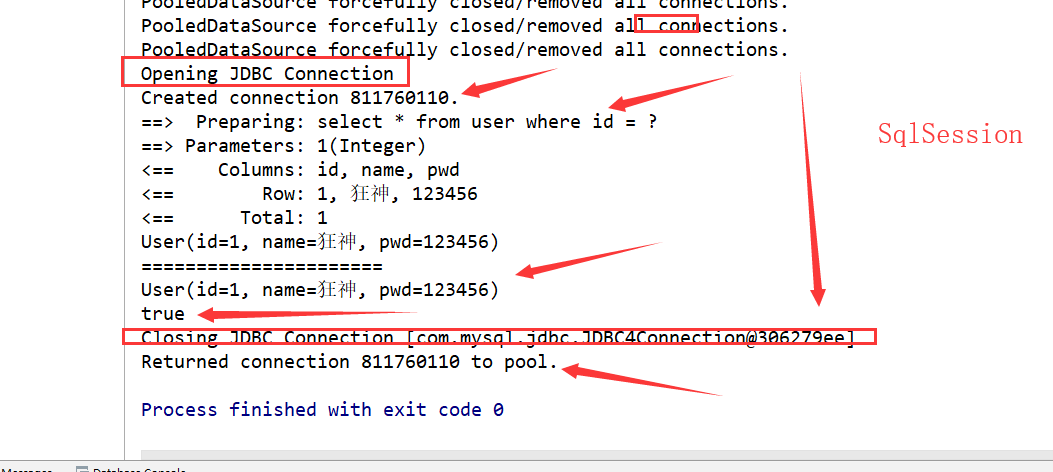
Cache invalidation:
-
Query different things
-
Adding, deleting and modifying operations may change the original data, so the cache will be refreshed!
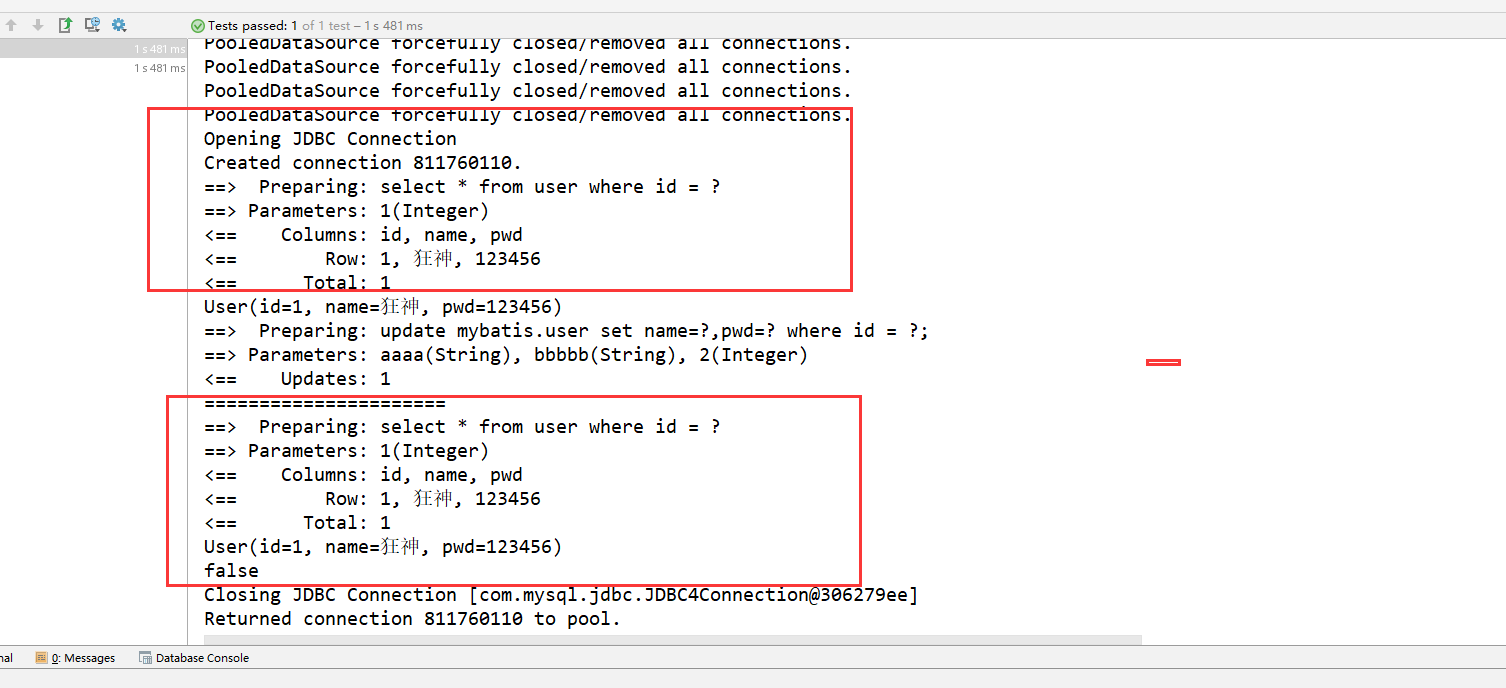
-
Query different mapper xml
-
Manually clean up the cache!
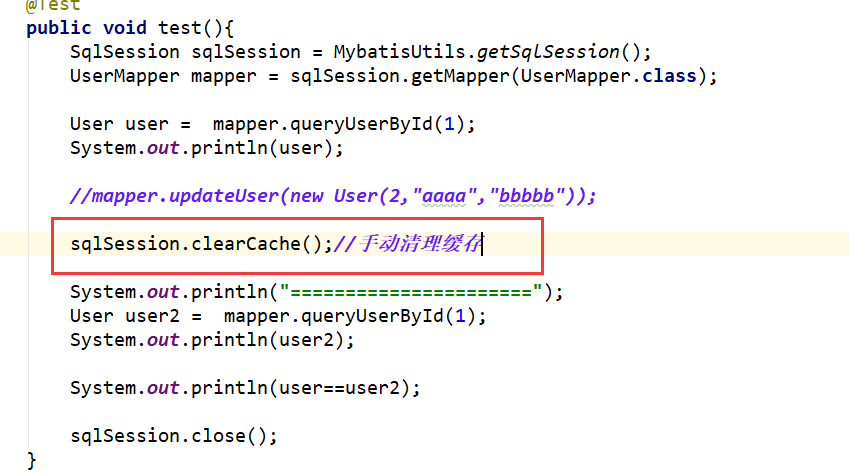
Summary: the L1 cache is enabled by default and is only valid for one SqlSession, that is, the interval from getting the connection to closing the connection!
The first level cache is a Map.
13.4 L2 cache
- L2 cache is also called global cache. The scope of L1 cache is too low, so L2 cache was born
- Cache based on namespace level, one namespace corresponds to one L2 cache;
- Working mechanism
- When a session queries a piece of data, the data will be placed in the first level cache of the current session;
- If the current session is closed, the L1 cache corresponding to this session is gone; But what we want is that the session is closed and the data in the L1 cache is saved to the L2 cache;
- The new session query information can get the content from the L2 cache;
- The data found by different mapper s will be placed in their corresponding cache (map);
Steps:
-
Turn on global cache
<!--Global display cache on--> <setting name="cacheEnabled" value="true"/>
-
Turn on in Mapper where you want to use L2 cache
<!--At present Mapper.xml Using L2 cache in--> <cache/>
You can also customize parameters
<!--At present Mapper.xml Using L2 cache in--> <cache eviction="FIFO" flushInterval="60000" size="512" readOnly="true"/> -
test
-
Problem: we need to serialize the entity class! Otherwise, an error will be reported!
Caused by: java.io.NotSerializableException: com.kuang.pojo.User
-
Summary:
- As long as the L2 cache is enabled, it is effective under the same Mapper
- All data will be put in the first level cache first;
- Only when the session is submitted or closed, it will be submitted to the secondary buffer!
13.5 cache principle
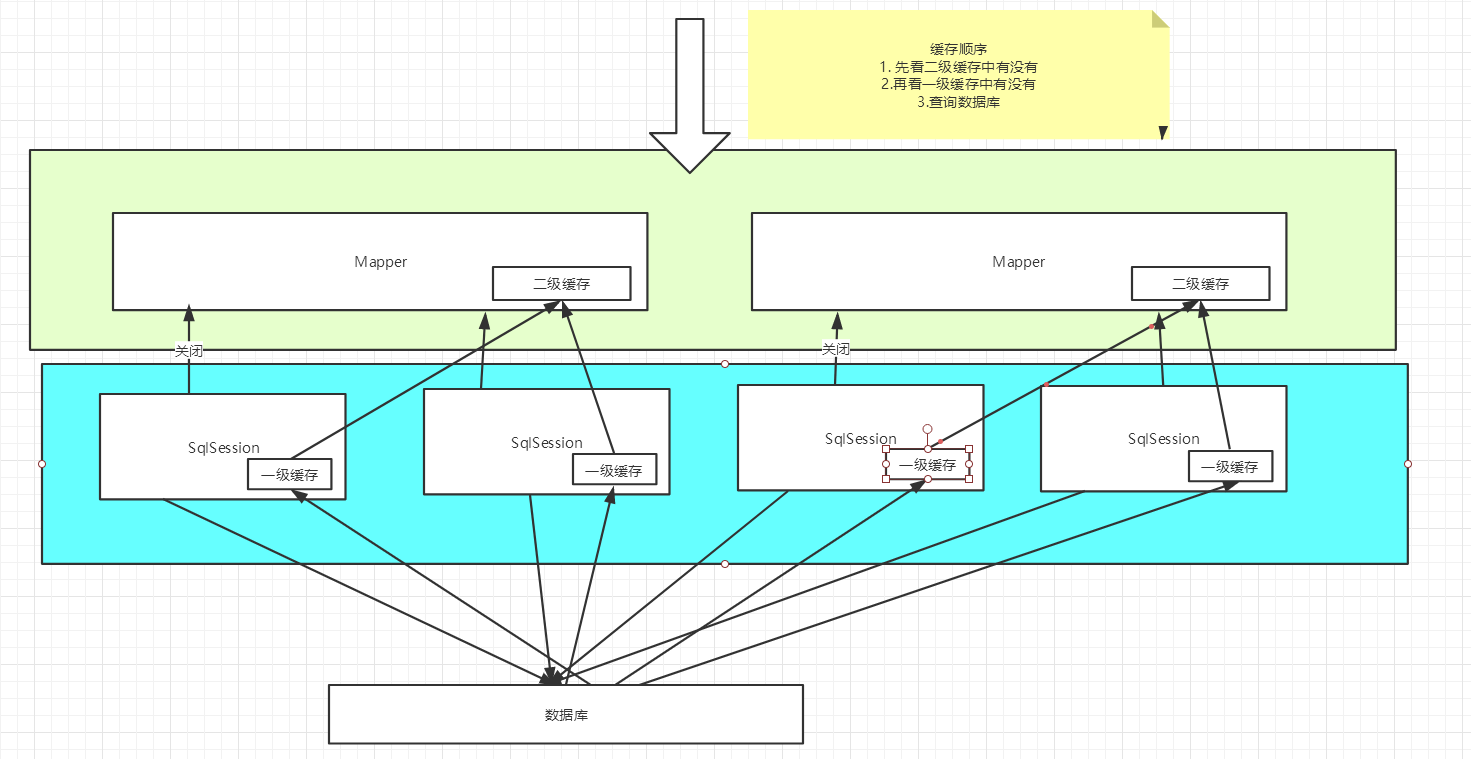
13.6. User defined cache ehcache
Ehcache Is a widely used open source Java Distributed cache. Mainly for general cache
To use ehcache in the program, you must first import the package!
<!-- https://mvnrepository.com/artifact/org.mybatis.caches/mybatis-ehcache -->
<dependency>
<groupId>org.mybatis.caches</groupId>
<artifactId>mybatis-ehcache</artifactId>
<version>1.1.0</version>
</dependency>
Specify our ehcache cache implementation in mapper!
<!--At present Mapper.xml Using L2 cache in--> <cache type="org.mybatis.caches.ehcache.EhcacheCache"/>
ehcache.xml
<?xml version="1.0" encoding="UTF-8"?>
<ehcache xmlns:xsi="http://www.w3.org/2001/XMLSchema-instance"
xsi:noNamespaceSchemaLocation="http://ehcache.org/ehcache.xsd"
updateCheck="false">
<!--
diskStore: Is the cache path, ehcache There are two levels: memory and disk. This attribute defines the cache location of the disk. The parameters are explained as follows:
user.home – User home directory
user.dir – User's current working directory
java.io.tmpdir – Default temporary file path
-->
<diskStore path="./tmpdir/Tmp_EhCache"/>
<defaultCache
eternal="false"
maxElementsInMemory="10000"
overflowToDisk="false"
diskPersistent="false"
timeToIdleSeconds="1800"
timeToLiveSeconds="259200"
memoryStoreEvictionPolicy="LRU"/>
<cache
name="cloud_user"
eternal="false"
maxElementsInMemory="5000"
overflowToDisk="false"
diskPersistent="false"
timeToIdleSeconds="1800"
timeToLiveSeconds="1800"
memoryStoreEvictionPolicy="LRU"/>
<!--
defaultCache: Default cache policy, when ehcache This cache policy is used when the defined cache cannot be found. Only one can be defined.
-->
<!--
name:Cache name.
maxElementsInMemory:Maximum number of caches
maxElementsOnDisk: Maximum number of hard disk caches.
eternal:Whether the object is permanently valid, but once it is set, timeout Will not work.
overflowToDisk:Whether to save to disk when the system crashes
timeToIdleSeconds:Set the allowed idle time of the object before expiration (unit: seconds). Only if eternal=false It is used when the object is not permanently valid. It is an optional attribute. The default value is 0, that is, the idle time is infinite.
timeToLiveSeconds:Set the allowable survival time of the object before invalidation (unit: seconds). The maximum time is between creation time and expiration time. Only if eternal=false When 0 is used as the default object, it is not valid.,That is, the survival time of the object is infinite.
diskPersistent: Whether to cache virtual machine restart data Whether the disk store persists between restarts of the Virtual Machine. The default value is false.
diskSpoolBufferSizeMB: This parameter setting DiskStore(Cache size of disk cache). The default is 30 MB. each Cache Each should have its own buffer.
diskExpiryThreadIntervalSeconds: The running time interval of disk failure thread is 120 seconds by default.
memoryStoreEvictionPolicy: When reached maxElementsInMemory When restricted, Ehcache The memory will be cleaned up according to the specified policy. The default policy is LRU(Least recently used). You can set it to FIFO(First in first out) or LFU(Less used).
clearOnFlush: Whether to clear when the amount of memory is maximum.
memoryStoreEvictionPolicy:The optional strategies are: LRU(Least recently used, default policy) FIFO(First in first out) LFU(Minimum number of visits).
FIFO,first in first out,This is the most familiar, first in, first out.
LFU, Less Frequently Used,This is the strategy used in the above example. To put it bluntly, it has always been the least used. As mentioned above, the cached element has a hit Properties, hit The smallest value will be flushed out of the cache.
LRU,Least Recently Used,The least recently used element in the cache has a timestamp. When the cache capacity is full and it needs to make room for caching new elements, the element with the farthest timestamp from the current time in the existing cache elements will be cleared out of the cache.
-->
</ehcache>
Redis database for caching! K-V